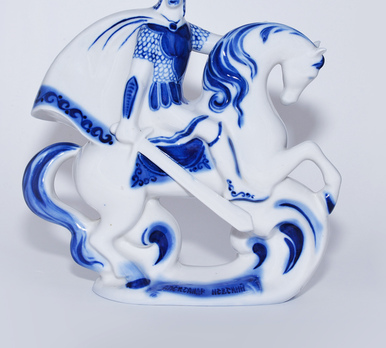The table sculpture from the museum is a miniature copy of the belfry of the Cathedral of St. Sophia. It was made in the 1970s and the 1980s at the Bronnitsky porcelain factory “Vozrozhdenie”.
The old stone belfry has always been a highlight of the Novgorod Kremlin and part of the city skyline, but the existing building has gone through some remodeling. After the World War II, scholars conducted special research studies to find out how the belfry had looked like in different historical periods.
The first information about the belfry of the Cathedral of St. Sophia dates back to 1437. A chronicler mentioned the cathedral when he wrote about a heavy flood, during which the stone Kremlin wall had been washed away. He specified that the old belfry, which stood on or near the wall, had collapsed into the Volkhov river. There was no detailed information, but researchers believe that this was the belfry of the Cathedral of St. Sophia.
In 1439, Archbishop Euthymius II had a new four-pillar belfry built — its brickwork is part of the modern bell tower. Between the wall of the Kremlin and the wall of the bell tower, Euthymius built stone chambers, which also still exist today.
The top of the belfry was decorated with five tall tents, which were removed in the 17th century. At the same time, new bells were brought to Novgorod from Moscow, which required narrower spans. Then the old arches were filled, six pillars with five new spans were put over them, and a small house was added to the belfry. At first, it was a one-story building, but later another floor was added above. The church wardens and the bell ringers of the cathedral lived in this house, and it has survived to the present day.
Today the bells no longer hang in the belfry hang — instead they are placed in front of it on a pedestal. The oldest bells are the two smaller ones weighing 1.3 and 3.3 tons. The first one was commissioned for Novgorod by Boris Godunov and cast in 1589. The second one was created in 1599 for the Khutynsky monastery by Pskov masters Athanasius Pankratiev, Vasily, and Joakim Ivanov. The largest bell was created in 1659 in the Kremlin by Yermolai Vasiliev. The average bells weighing about five and ten tons were cast in 1677 and 1839, respectively.
The old stone belfry has always been a highlight of the Novgorod Kremlin and part of the city skyline, but the existing building has gone through some remodeling. After the World War II, scholars conducted special research studies to find out how the belfry had looked like in different historical periods.
The first information about the belfry of the Cathedral of St. Sophia dates back to 1437. A chronicler mentioned the cathedral when he wrote about a heavy flood, during which the stone Kremlin wall had been washed away. He specified that the old belfry, which stood on or near the wall, had collapsed into the Volkhov river. There was no detailed information, but researchers believe that this was the belfry of the Cathedral of St. Sophia.
In 1439, Archbishop Euthymius II had a new four-pillar belfry built — its brickwork is part of the modern bell tower. Between the wall of the Kremlin and the wall of the bell tower, Euthymius built stone chambers, which also still exist today.
The top of the belfry was decorated with five tall tents, which were removed in the 17th century. At the same time, new bells were brought to Novgorod from Moscow, which required narrower spans. Then the old arches were filled, six pillars with five new spans were put over them, and a small house was added to the belfry. At first, it was a one-story building, but later another floor was added above. The church wardens and the bell ringers of the cathedral lived in this house, and it has survived to the present day.
Today the bells no longer hang in the belfry hang — instead they are placed in front of it on a pedestal. The oldest bells are the two smaller ones weighing 1.3 and 3.3 tons. The first one was commissioned for Novgorod by Boris Godunov and cast in 1589. The second one was created in 1599 for the Khutynsky monastery by Pskov masters Athanasius Pankratiev, Vasily, and Joakim Ivanov. The largest bell was created in 1659 in the Kremlin by Yermolai Vasiliev. The average bells weighing about five and ten tons were cast in 1677 and 1839, respectively.



